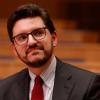
Catholic efforts to aid those in Japan most affected by the March 11 earthquake and tsunami are including people from across the country and at all levels of society, say Western missionaries and agency directors there.
Bishop Martin Tetsuo Hiraga of Sendai, the city nearest to the epicenter of the quake, met with the president of Caritas Japan and other bishops to set up a process to distribute aid to the area, Sr. Cecilia Haruko Ishikawa, the director of the department of social concerns of the Japanese Catholic bishops’ conference, told NCR in an e-mail.
“We are now gathering information about the affected area, especially about…parish churches and priests,” wrote Ishikawa, who is a member of the Handmaids of the Sacred Heart of Jesus.
Hiraga and his diocesan chancellor, Fr. Peter Shiro Komatsu will serve as the director and vice director of an emergency center located in the diocese, UCA News reported yesterday.
Fr. Bonnie Mendes, regional coordinator for Caritas Asia, stressed that Caritas and local churches are centralizing all their relief efforts with the government's efforts because its response has been highly organized.
In e-mail conversations with NCR over the past few days, missionaries in Japan stressed the extent of the destruction caused by the tsunami.
Maryknoll Fr. Roberto Rodriguez, who is based in Tokyo, wrote “there is fear and anxiety in the people” there, noting that the probable cause was the threat of nuclear disaster.
“People are stocking up on food, drinking water, gasoline and other necessities,” Rodriguez wrote. “Many are leaving Tokyo...school is closed...trains are not running as usual and we have [begun] to experience the rationing of electricity.”
Divine Word Fr. Mick Seigel, a member of the Japanese bishops’ commission for justice and peace and a permanent research fellow at Nanzan University, said the evacuations caused by the fears of a meltdown at the Fukushima nuclear power plant are only adding to the frustrations to the people in the earthquake zone.
“Some...are being asked to evacuate when they really need to be looking for missing loved ones and seeing what can be salvaged from their homes,” Seigel said.
People at the center of the disaster are also dealing with separation from their families, as the quake struck in the afternoon when people were at work or school.
In that regard, last week’s quake “was very different” from the 6.8 earthquake that struck near Kobe, Japan in 1995, and occurred in the early morning hours when most people were still at home, Seigel said.
Often people forget the trauma that happens following the disaster, said Bill Canny, director of emergency operations for Catholic Relief Services, and recovery is not short.
"Fifty percent of people in an earthquake of significance suffer some sort of depression or trauma three years later," he said, adding that the church in Japan is very concerned about that.
Yet, in the face of the destruction caused by the quake and tsunami, each of the missionaries contacted by NCR mentioned that Japanese of every stripe have been contributing to the relief effort.
Relating a report from Guadalupe Missionary Fr. Jose Gonzalez in Sendai, Rodriguez said parishioners there have formed teams to help “in any way possible” and have been taking donations for the evacuees to the cathedral.
Corporations, said Seigel, “have been contributing everything from food and water to diapers and mobile phones.”
Maryknoll Fr. Jim Mylett, who has been in Japan since 1970 and is based on the northern island of Hokkaido, described the situation in an e-mail sent to Maryknoll colleagues by citing an Old Testament story:
“Right now Japan is like Israel when they came back from the Exile and found the Temple destroyed and their homes occupied....It is a time when people lose heart, and the church is trying to be a beacon of hope in these difficult circumstances.”
[Zoe Ryan is an NCR intern. Joshua McElwee is an NCR staff writer.]
Editor's Note: For CNS photos of the continuing disaster in Japan, see the slideshow below.



